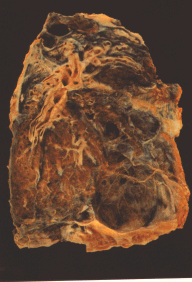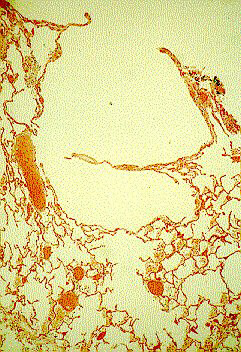
COPD has had many names in the past including; Chronic Obstructive Airways Disease, (COAD); Chronic Obstructive Lung Disease, (COLD); Chronic Airflow Limitation, (CAL or CAFL) and Chronic Airflow Obstruction. COPD actually comprises two related diseases, chronic bronchitis and emphysema, one rarely occurring without a degree of the other. The definition of COPD, that is recognised by both the American Thoracic Society and the European Respiratory Society, is a disorder that is characterised by reduced maximal expiratory flow and slow forced emptying of the lungs; features that do not change markedly over several months. This limitation in airflow is only minimally reversible with bronchodilators.
Emphysema has a pathological definition, which is a condition where there is permanent destructive enlargement of of the airspaces distal to the terminal bronchioles without obvious fibrosis (fig.2). Chronic bronchitis is defined clinically by the presence of chronic bronchial secretions, enough to cause expectoration, occurring on most days for a minimum of 3 months of the year for 2 consecutive years. The pathological basis of chronic bronchitis is mucus hypersecretion secondary to hypertrophy of the glandular elements of the bronchial mucosa. Patients with COPD have features of both conditions, although one may be more prominent than the other.
Fig.2a: Section through emphysematous lung. Note subpleural bullae and enlarged airspaces.

Fig. 2b: Section through emphysematous lung with marked destruction of lung parenchyma repalced with huge bullae.

Fig.2c: Photomicrograph of emphysematous lung. Note enlarged airspaces and lack of fibrosis.